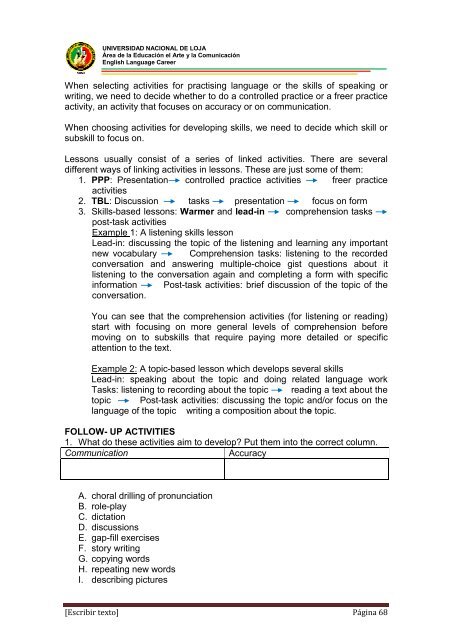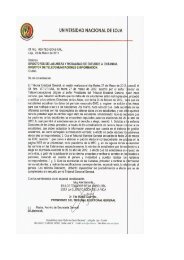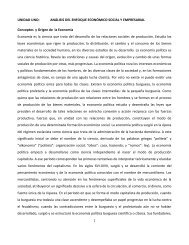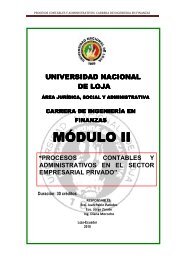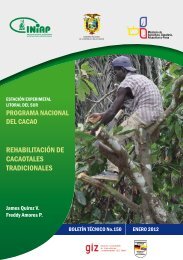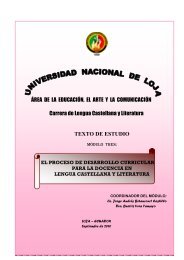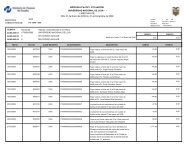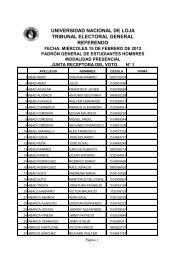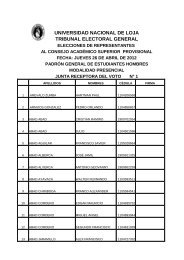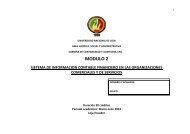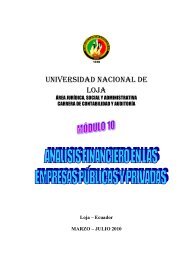module 5 planning of the english language teaching-learning process
module 5 planning of the english language teaching-learning process
module 5 planning of the english language teaching-learning process
Create successful ePaper yourself
Turn your PDF publications into a flip-book with our unique Google optimized e-Paper software.
UNIVERSIDAD NACIONAL DE LOJA<br />
Área de la Educación el Arte y la Comunicación<br />
English Language Career<br />
When selecting activities for practising <strong>language</strong> or <strong>the</strong> skills <strong>of</strong> speaking or<br />
writing, we need to decide whe<strong>the</strong>r to do a controlled practice or a freer practice<br />
activity, an activity that focuses on accuracy or on communication.<br />
When choosing activities for developing skills, we need to decide which skill or<br />
subskill to focus on.<br />
Lessons usually consist <strong>of</strong> a series <strong>of</strong> linked activities. There are several<br />
different ways <strong>of</strong> linking activities in lessons. These are just some <strong>of</strong> <strong>the</strong>m:<br />
1. PPP: Presentation controlled practice activities freer practice<br />
activities<br />
2. TBL: Discussion tasks presentation focus on form<br />
3. Skills-based lessons: Warmer and lead-in comprehension tasks<br />
post-task activities<br />
Example 1: A listening skills lesson<br />
Lead-in: discussing <strong>the</strong> topic <strong>of</strong> <strong>the</strong> listening and <strong>learning</strong> any important<br />
new vocabulary Comprehension tasks: listening to <strong>the</strong> recorded<br />
conversation and answering multiple-choice gist questions about it<br />
listening to <strong>the</strong> conversation again and completing a form with specific<br />
information Post-task activities: brief discussion <strong>of</strong> <strong>the</strong> topic <strong>of</strong> <strong>the</strong><br />
conversation.<br />
You can see that <strong>the</strong> comprehension activities (for listening or reading)<br />
start with focusing on more general levels <strong>of</strong> comprehension before<br />
moving on to subskills that require paying more detailed or specific<br />
attention to <strong>the</strong> text.<br />
Example 2: A topic-based lesson which develops several skills<br />
Lead-in: speaking about <strong>the</strong> topic and doing related <strong>language</strong> work<br />
Tasks: listening to recording about <strong>the</strong> topic reading a text about <strong>the</strong><br />
topic Post-task activities: discussing <strong>the</strong> topic and/or focus on <strong>the</strong><br />
<strong>language</strong> <strong>of</strong> <strong>the</strong> topic writing a composition about <strong>the</strong> topic.<br />
FOLLOW- UP ACTIVITIES<br />
1. What do <strong>the</strong>se activities aim to develop? Put <strong>the</strong>m into <strong>the</strong> correct column.<br />
Communication<br />
Accuracy<br />
A. choral drilling <strong>of</strong> pronunciation<br />
B. role-play<br />
C. dictation<br />
D. discussions<br />
E. gap-fill exercises<br />
F. story writing<br />
G. copying words<br />
H. repeating new words<br />
I. describing pictures<br />
[Escribir texto] Página 68


